
If you're looking for a dog that resembles a Pit Bull, you've come to the right place. The American Bulldog, for example, has a similar muscular build and broad chest.
The Bull Terrier is another breed that shares some physical characteristics with Pit Bulls. Its distinctive egg-shaped head and muscular physique make it a popular choice for those who want a dog that looks like a Pit Bull.
While they may look similar, it's essential to remember that each breed has its unique characteristics and temperaments. The American Staffordshire Terrier, a breed often mistaken for a Pit Bull, is known for its friendly and outgoing personality.
In this guide, we'll explore the different breeds that resemble Pit Bulls, their characteristics, and what to expect from each breed.
Expand your knowledge: American Bull Dog Pit Mix
Dogs That Look Like Pit Bulls
If you're considering bringing home a dog that looks like a Pit Bull, it's essential to know their needs and tendencies. American Pit Bull Terriers, for instance, require a lot of attention and training from an early age to overcome their stubbornness and bossiness.
They need to be socialized properly to avoid aggression towards other dogs, especially if they're not properly trained. In fact, letting them run loose in dog parks is not a good idea, as they'll never back down from a fight. This is why it's crucial to provide them with tough, durable toys that can withstand their powerful jaws and strong chewing instinct.
If you're planning to travel with your dog, be aware of breed-specific legislation in your area and neighboring regions. This breed is often included in such laws, so it's essential to know the rules beforehand. With the right training, socialization, and care, a dog that looks like a Pit Bull can make a wonderful companion.
For another approach, see: Pit Bulls Should Not Be Banned
Dachshund Dach
The Dachshund Pitbull Mix, affectionately known as the Bull Dach, is a unique and lovable companion. They thrive on physical contact with human beings and are not naturally aggressive unless provoked.
These dogs are playful and enjoy spending time engaging in activities like playing with a softball or other chewing toys. They need plenty of exercise and mental stimulation to prevent boredom and destructive behavior.
Some health issues to be aware of when owning a Bull Dach include epilepsy, hypothyroidism, and eye disorders. Regular veterinary check-ups and a balanced diet can help manage these conditions.
To keep your Bull Dach's coat looking its best, brush it regularly with a toothed comb to prevent matting and tangling. The coat can be short or medium in length, so be sure to choose the right grooming tools for your dog's needs.
Highlights
Pit Bulls require regular exercise and mental stimulation, but they can thrive in apartments if provided with enough attention and training.
They need to be trained and socialized when young to overcome their tendencies toward stubbornness and bossiness, which can make them hard to handle if they haven't learned who's in charge.
A well-exercised and mentally stimulated Pit Bull is a happy Pit Bull.
They have a great need to chew, and powerful jaws make quick work of cheap or flimsy toys, so give them only tough, durable toys that can't be chewed up and swallowed.
Pit Bulls can get along with small children and other small animals if socialized properly.
Here are some key characteristics of Pit Bulls:
- Height: 17-21 inches (at the shoulder)
- Weight: 35-60 pounds (male), 30-50 pounds (female)
- Coat: Red, fawn, white, black, blue, brindle— plus any of these colors with white.
- Coat Length: Short dense fur with no undercoat
Breed-Specific Information
Pit Bulls are a catch-all term, but a registered American Pit Bull Terrier, or APBT, is recognized by the United Kingdom's Kennel Club. They have a similar appearance to Staffordshire Bull Terriers, but some Pit Bulls can be taller or leaner.
Here are some key characteristics of Pit Bulls:
- Height: 17-21 inches (at the shoulder)
- Weight: 35-60 pounds (male), 30-50 pounds (female)
- Coat: Red, fawn, white, black, blue, brindle— plus any of these colors with white
- Coat Length: Short dense fur with no undercoat
Staffordshire Bull Terriers, on the other hand, are short, stout, and adorable. They have a muscular, broad, and stout build, with a square head and pronounced cheek muscles.
Boxer
The Boxer is a wonderful breed that makes a great companion for many families. They have a short and smooth coat which is often tidy on its own, making them a low-maintenance grooming option.
Boxer dogs are known to be high-energy dogs that require regular exercise to keep them happy and healthy. They'll often run around the vicinity or get your attention to play fetch.
One of the best things about Boxers is their loyalty and protective nature. They can become wary of suspicious people and actions, making them an excellent watchdog for your household.
Here are some key characteristics of the Boxer breed:
- Short and smooth coat
- High energy level
- Loyal and protective
- Excellent watchdog
Husky
The Husky is a wonderful breed, and if you're considering bringing one home, here are some essential facts to keep in mind.
The adult Husky requires a daily food intake of at least three cups of high-quality food, which should be divided into two meals.
You'll want to adjust the amount of food based on the level of physical activity, as Huskies are naturally energetic dogs.
Huskies are generally a healthy breed, but they may be susceptible to certain health issues, including heart diseases and eye disorders.
If you're interested in adopting a Husky, you can contact breed-specific shelters or professional breeders for assistance.
Remember to provide regular veterinary check-ups to monitor your Husky's health and catch any potential issues early on.
Readers also liked: Similar Dogs to Husky
Corgi
The Corgi is a beloved breed known for its short stature and affectionate nature. They are a relatively small dog, but they pack a big punch when it comes to loyalty and love for their owners.
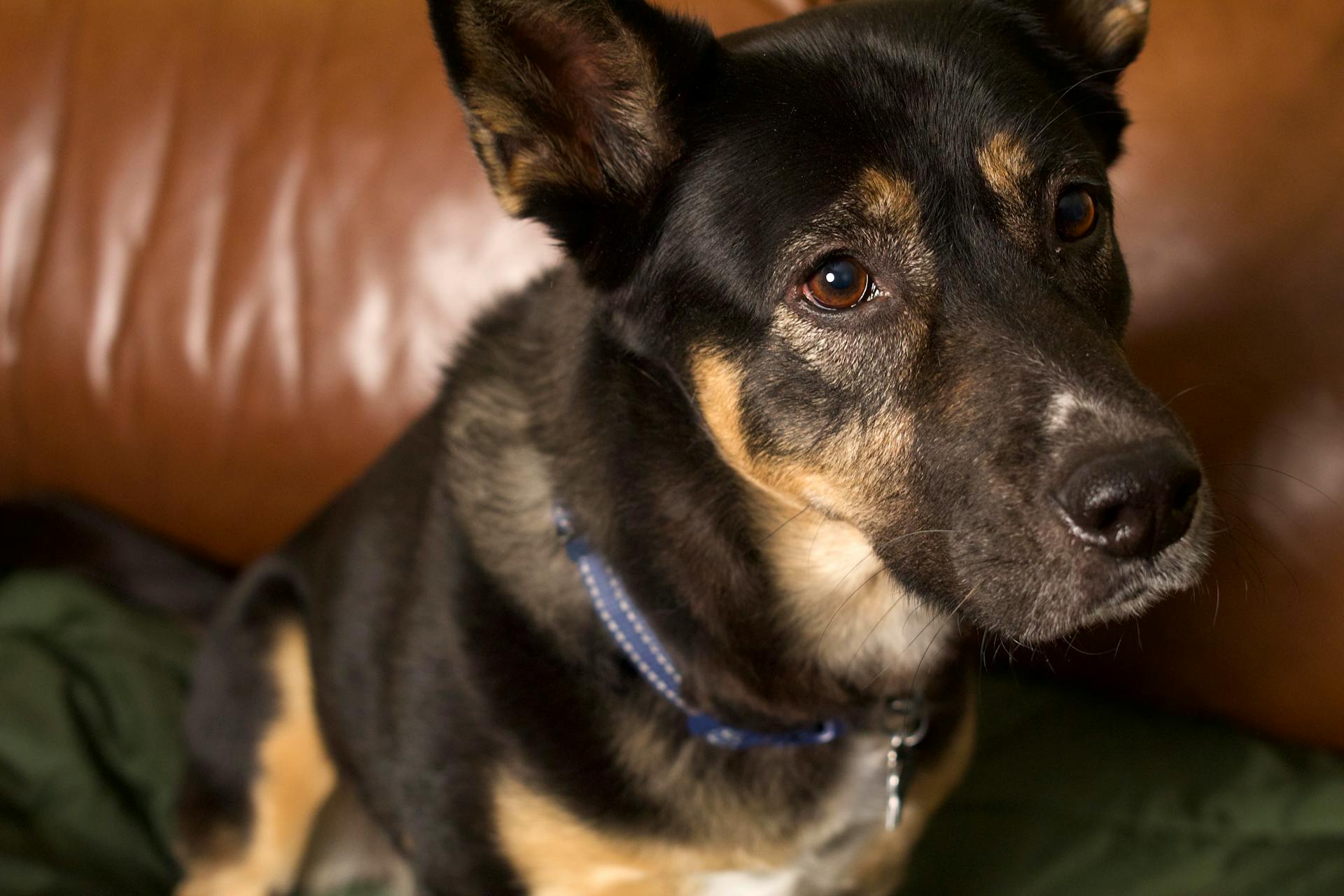
One thing to keep in mind when considering a Corgi as a pet is their potential for joint problems. This is especially true for Corgi Pitbull Mixes, which can inherit the added weight of the Pitbull parent breed, putting them at risk for hip dysplasia.
A Corgi's short coat requires regular grooming to prevent matting and tangling. Brushing at least once a week is a must to keep their coat looking its best.
Corgis are highly intelligent and eager to please, making them a joy to train. They thrive on attention and affection, and they'll often go to great lengths to get it.
A different take: Pitbull Dog Mixes
German Shepherd
The German Shepherd breed has a rich history, created to become herding and service dogs in the European area.
They originated from Germany and were bred to herd sheep, making them highly intelligent and trainable.
You'll want to engage them in physical activity regularly, but be careful due to health reasons.
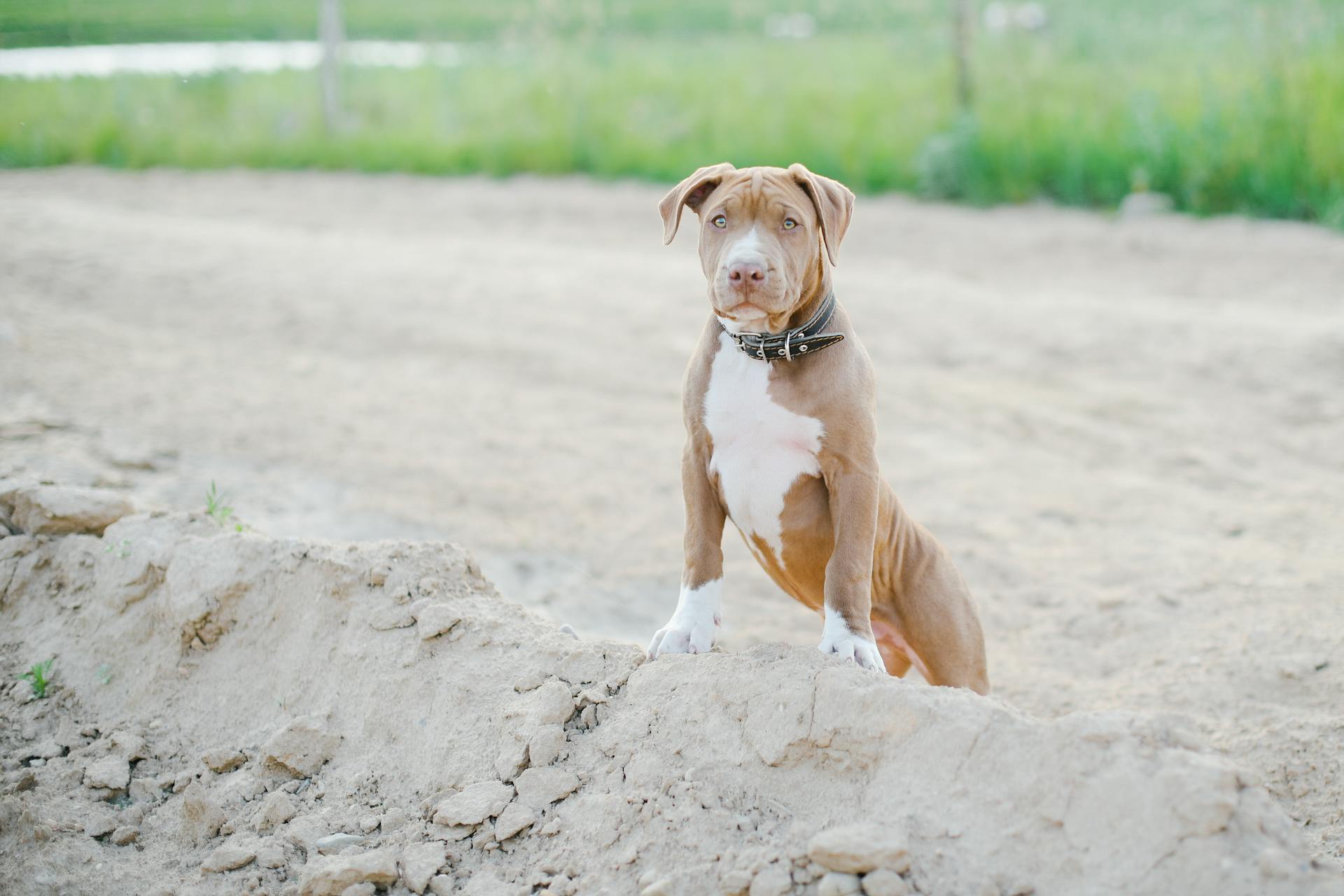
Daily walks and off-leash exercises can help keep them happy and healthy.
German Shepherd Pitbull Mix dogs, also known as German Pitbulls, are moderate shedders and require regular brushing.
Here's a rough guide to their grooming needs:
- Brush their coat 2-4 times per week
This breed is known for being highly energetic, so be prepared to keep them active and engaged.
Beagle
Beagles are wonderful companions, but it's essential to remember that they can live up to 15 years with proper care.
Beagles are prone to ear infections, elbow dysplasia, and allergies, so regular veterinary check-ups are a must.
A healthy diet is crucial for Beagles, and restricting fatty food and excess treats can help protect them against infection and other diseases.
If you're considering bringing a Beagle into your family, be sure to do thorough research on available and qualified breeders near you, or consider searching for Beagles in rescue shelters.
Here are some key health considerations for Beagles:
- Ear infections
- Elbow dysplasia
- Allergies
Labrador
The Labrador breed has a rich history, originating in Canada as a trusted helper dog. This breed was developed to assist and provide companionship.
You might like: Dog Breed That Looks like a Pug

In its early days, the Labrador was bred to be a working dog, not just a pet. They were highly valued for their intelligence, loyalty, and strong work ethic.
Labradors are known for their friendly nature, which makes them a popular choice as family pets. However, they do have a tendency to chew things often, so be prepared to provide plenty of chew toys.
Early socialization is crucial to ensure the safe interaction of your family and the dog. This means exposing your Labrador to new people, places, and experiences from an early age.
Labradors are a relatively adaptable breed and can thrive in a variety of living situations, but they do require regular exercise and mental stimulation to prevent boredom and destructive behavior.
Here's a rough guide to the size and weight of Labradors:
Keep in mind that these are general estimates, and the actual size and weight of your Labrador will depend on various factors, including its lineage and diet.
Chihuahua
The Chihuahua is a small dog breed that can make a great companion. They come in a variety of coat lengths, so you may need to clip their nails regularly to avoid injuries to family members.
Their exercise needs are relatively low compared to other breeds, but they still require regular walks and playtime. You can consider taking them to a dog park to socialize with other dogs.
To care for a Chihuahua, you'll want to find a reputable breeder. Asking for referrals from a local veterinarian and breed club officers can be a good place to start.
Chow Chow
The Chow Chow is a unique breed that requires special attention. It's essential to provide a high-quality diet with high nutritional value to help your Chow Chow live its best life.
You should consider joining a training class to help your Chow Chow learn good behavior and manners. This can be especially helpful if you're a first-time dog owner.
Chow Chows need plenty of exercise and space to roam. They are more suitable for open-spaced living rather than an apartment, and they require about 30 minutes of exercise daily.
If you're thinking of getting a Chow Chow, be aware that they can be protective of their family and territory. They may have strong prey drive and aggressive tendencies, so it's crucial to supervise their interaction with small children and other animals.
Border Collie
If you're considering bringing a Border Collie into your family, you should know that they can have intense herding instincts and prey-oriented behaviors.
Their intelligence is one of their best qualities, but it also means they can get bored if they don't have enough mental and physical stimulation.
You can help prevent boredom by providing your Border Collie with plenty of exercise and engaging activities, such as agility training or interactive puzzle toys.
A healthy Border Collie overall, but you should try to avoid allergens that may cause allergies for the dog.
Here are some common allergens to watch out for:
- Dust
- Mold
- Pollen
If you notice any signs of malnutrition in your Border Collie, such as weight loss or lethargy, it's essential to consult a veterinarian as soon as possible.
Australian Shepherd
The Australian Shepherd is a breed that originated in the Western United States, where it worked as a herder.
Its history is well-documented, and it's known for its intelligence and high energy levels. This breed requires regular exercise and mental stimulation to prevent boredom and destructive behavior.
You'll need to engage your Australian Shepherd in various physical and mental activities to keep them happy and healthy. Food-dispensing toys are an excellent way to stimulate their mind and keep them occupied.
Australian Shepherds are highly intelligent and trainable, making them a popular choice as working dogs. They're also great with families and children, as long as they receive proper socialization and training.
If you're considering bringing an Australian Shepherd into your family, be prepared to provide plenty of exercise and attention. With the right care and training, they can make wonderful companions.
Recommended read: Mini Aussie Shepherd Mix
Pug
The Pug is a unique breed that requires some special attention.
The Pug Pitbull Mix, also known as the Pugbull, can range in size from 12 to 15 inches.
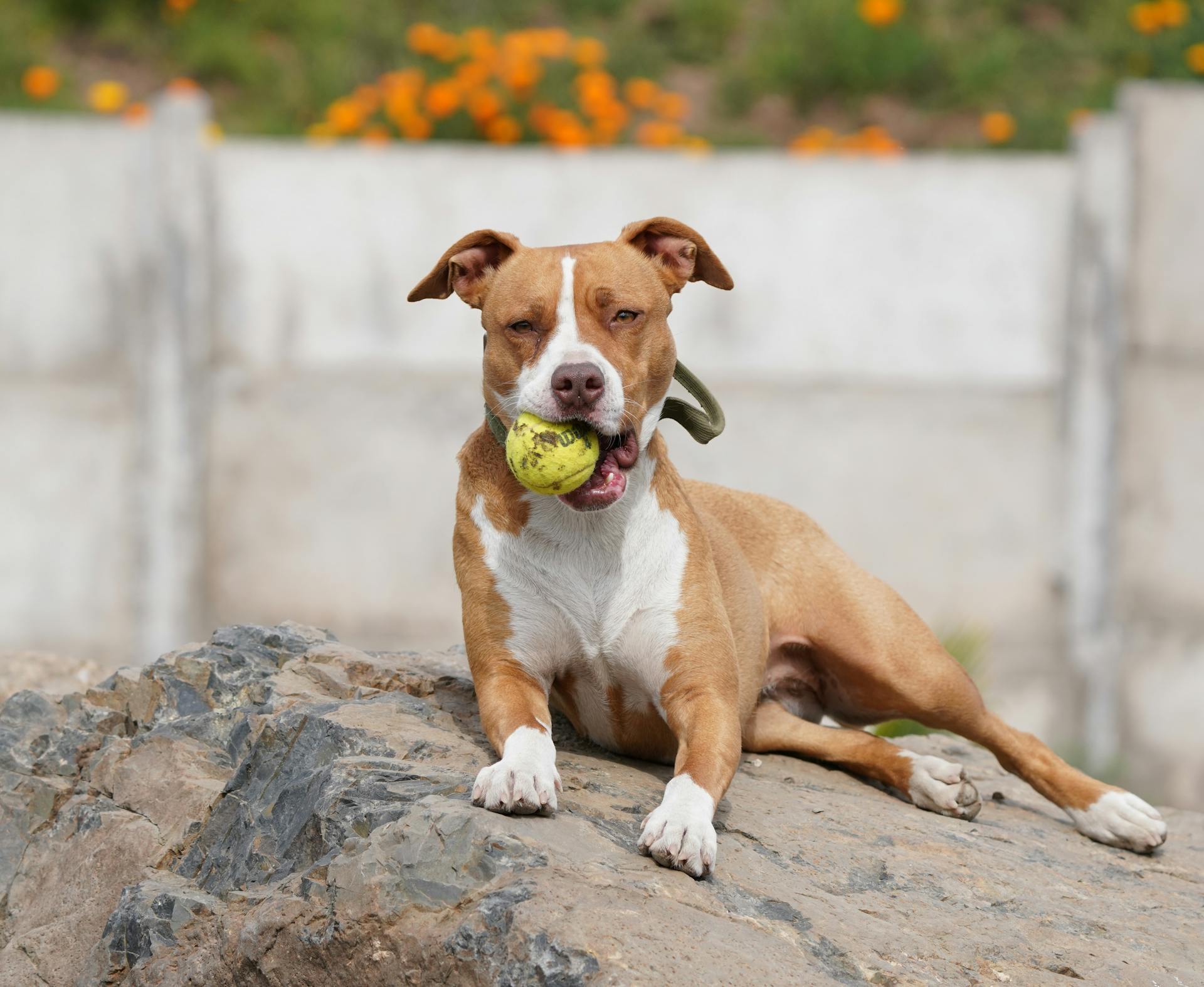
Pug Pitbull Mix dogs are prone to developing patellar luxation and hip dysplasia, so regular exercise is crucial.
Regular exercise will also help prevent destructive and mischievous behaviors in Pug Pitbull Mix dogs.
You can help keep your Pug Pitbull Mix healthy with a moderate activity level, such as running around a fenced-in yard or taking them out for a brisk walk.
A good starting point for feeding your adult Pug Pitbull Mix is two cups of high-quality dry food per day.
Here's a quick rundown of the Pug Pitbull Mix's exercise needs:
- Allow them to run around your fenced-in yard
- Take them out for a brisk walk
Cocker Spaniel
The Cocker Spaniel is a breed that originated in Spain, where they were split into two groups: companion dogs and hunting dogs. They were known for their hunting skills, particularly when it came to catching woodcock.
Their friendly and outgoing personalities are a big part of their appeal. You can expect a Cocker Spaniel to be a great companion and a loving family pet.
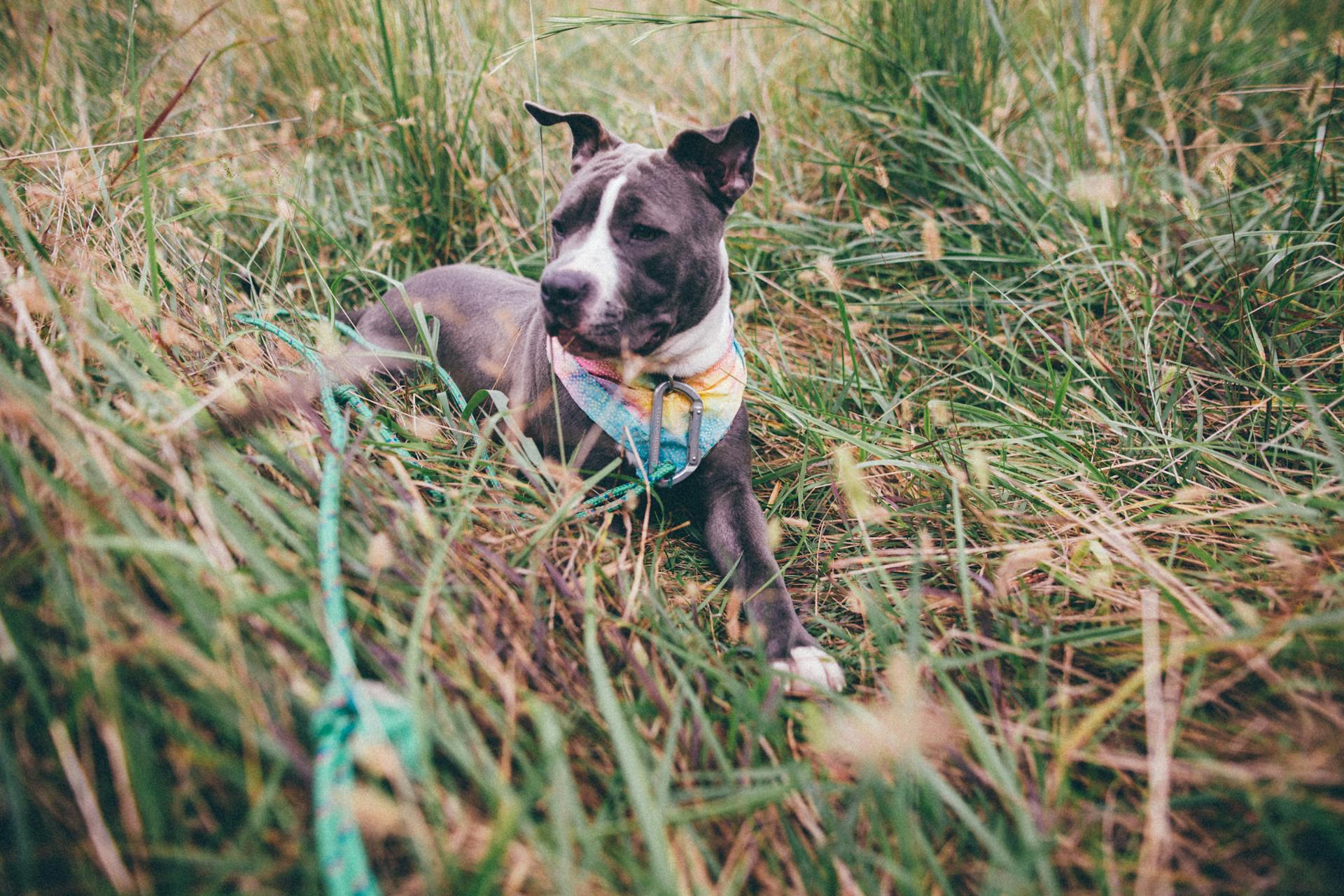
One of the things you'll love about Cocker Spaniels is their affectionate nature. They love to snuggle up on the couch and get attention from their owners.
They're also a relatively low-maintenance breed when it comes to grooming. A pin brush can help keep their coat moist and shiny, and they're a moderate shedder.
Their love of playtime is another great quality of Cocker Spaniels. They're perfect for families with little kids, as they're patient and gentle.
Here's an interesting read: Pit Bulls Love
Shar Pei
The Shar Pei is a unique breed originating from southern China, where they were raised as guardians and hunters.
Their history is rooted in their purpose, and as a result, they have a strong work ethic.
Shar Pei Pitbull Mix dogs, also known as Shar Pits, have a relatively low to moderate shedding coat that requires weekly brushing to remove loose fur.
You'll need to commit to regular grooming sessions to keep their coat looking its best.
To keep your Shar Pei or Shar Pit happy and healthy, they require a minimum of one hour of exercise per day.
Some fun activities you can try with your Shar Pei include playing catch, fly ball, and weight pulling.
You might like: Shar Pei Bull Terrier Mix
Akita
The Akita is a breed that's known for being loyal and gentle. They're also a bit more independent than some other breeds, so they can be a good fit for owners who don't mind a bit of alone time.
As they age, Akitas can develop some health issues, including progressive retinal atrophy, heart diseases, and hip dysplasia. These conditions can be managed with proper care and attention.
If you're considering bringing an Akita into your family, it's essential to find a reputable breeder who can provide health clearance for the parent breeds. This can help ensure that your new furry friend stays healthy for years to come.
Akitas are generally a relatively healthy breed, but like all breeds, they can be prone to certain health issues. Here are some potential health concerns to be aware of:
Blue Heeler
The Blue Heeler is a fantastic breed that's known for its high energy levels and endurance. They're a great companion dog and can even become working dogs on farms.
They enjoy spending their energy while playing with their family, which makes them a perfect fit for active households. This breed needs plenty of physical and mental stimulation to prevent boredom and destructive behavior.
The Blue Heeler has plenty of endurance, which means they can keep up with their family's active lifestyle. They can participate in activities like running, playing catch, and walking.
Here are some suggested activities for Blue Heelers:
- Running
- Playing catch
- Walking
When it comes to feeding your Blue Heeler, it's essential to give them the right amount of food at the right time. I recommend feeding them three times a day, and the amount will depend on their weight and level of physical activity.
French Dog
The French Bulldog Pitbull Mix, also known as the French Pitbull, is a breed that can get along with small children and other small animals. Early socialization and training are crucial for this mixed breed.
This dog has a moderate level of energy, which means it needs regular exercise but doesn't require intense physical activity. A leisurely walk around the neighborhood is a great way to keep it happy and healthy.
If you're considering adopting a French Pitbull, you can find them through breed-specific rescue shelters or reputable breeders in your area.
Recommended read: Small Bull Terrier Breeds
Golden Retriever
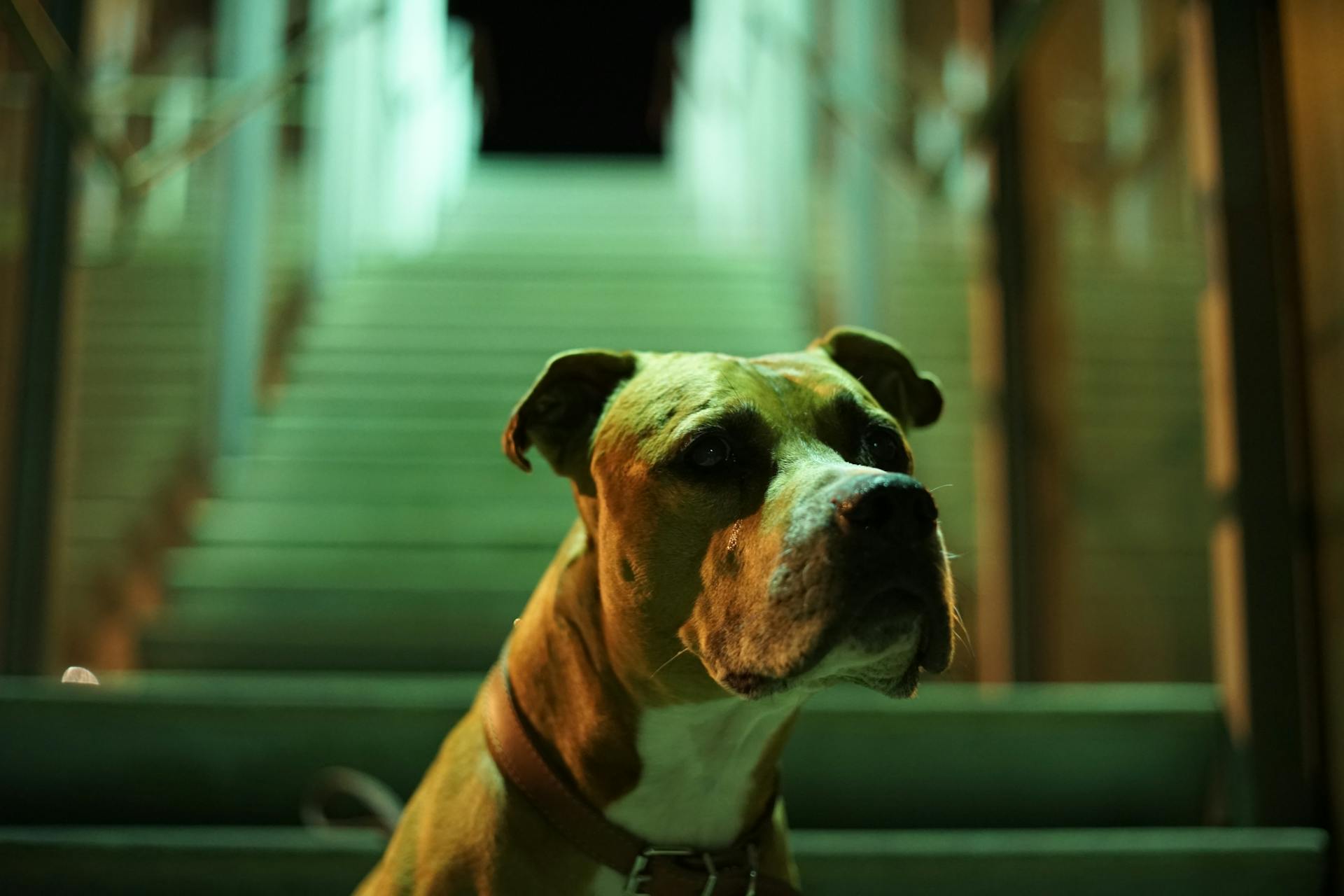
The Golden Retriever is a breed known for its amiable disposition, which makes it an excellent addition to families and as a companion dog.
One of the benefits of owning a Golden Retriever is that it has a more manageable coat than some other breeds, requiring regular brushing to keep it in good condition.
In terms of health, daily physical activity is crucial to protect the dog from various diseases, so be sure to provide a healthy exercise regimen for your Golden Retriever.
Proper training is also essential for any dog, but it's particularly important for breeds with a reputation for being aggressive, such as the Pitbull. With the right training, you can help tame their aggressiveness and bring out their friendly side.
Explore further: Newfoundland Dog and Golden Retriever
Great Pyrenees
The Great Pyrenees is a large and majestic breed, known for its loyalty and protective nature. They are wary of suspicious actions and people, making them suitable watchdogs.
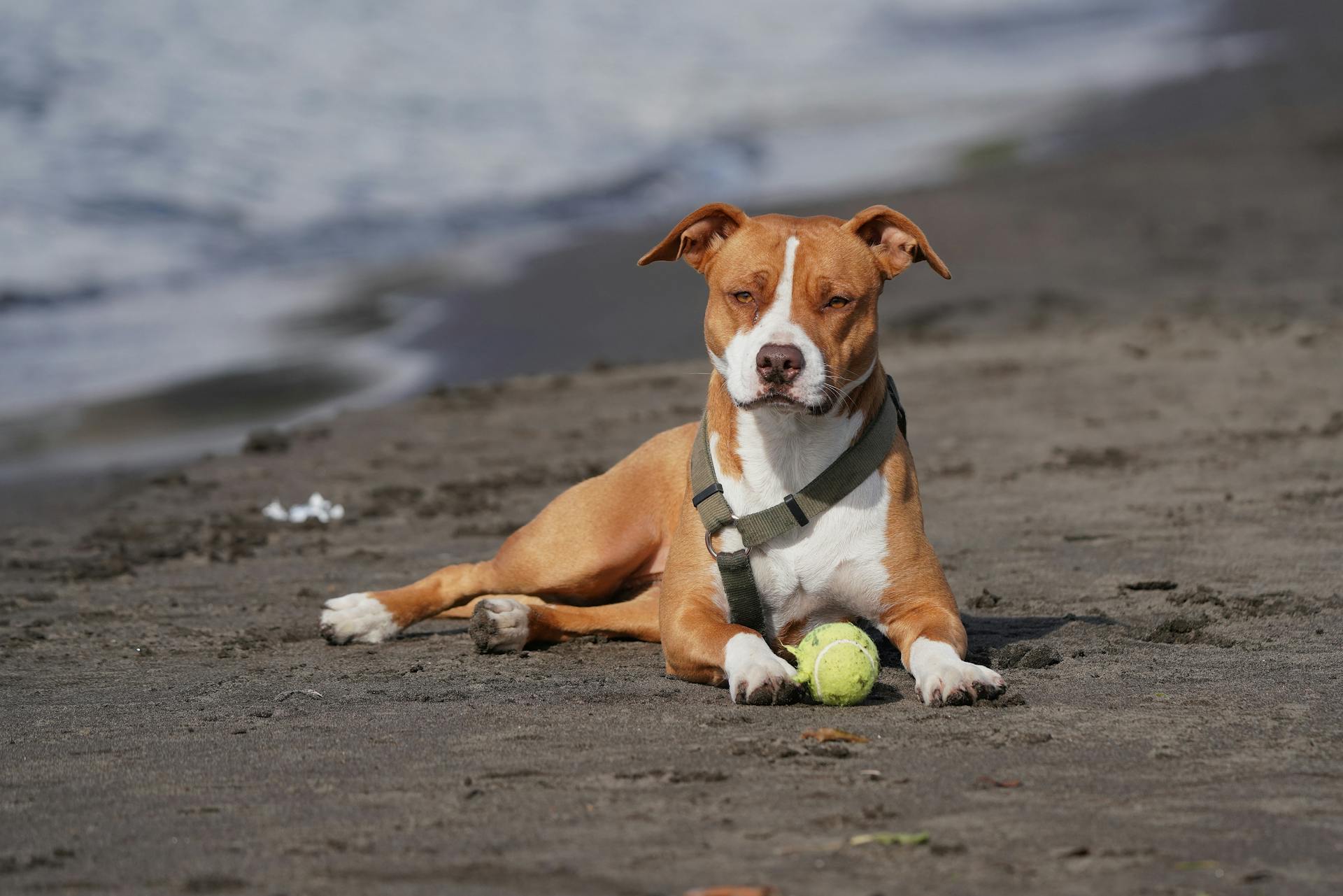
The Great Pyrenees has a double coat that requires regular grooming to prevent matting. You should comb and brush the coat every two days to keep it looking its best.
The Great Pyrenees is prone to certain health issues, including hip dysplasia and patellar luxation. These conditions can be painful and debilitating, so it's essential to be aware of the warning signs and seek veterinary care early.
Some of the health issues that can affect the Great Pyrenees include:
- Cerebellar ataxia
- Hip dysplasia
- Patellar luxation
If you suspect that your Great Pyrenees is suffering from one of these conditions, your veterinarian may recommend diagnostic tests such as chest x-rays, bone biopsy, and blood analysis.
Rhodesian Ridgeback
The Rhodesian Ridgeback is a breed that originated in Africa, specifically as a house guardian and excellent hunter. They were known for their unique characteristic of having a ridge of hair running along their back in the opposite direction of their coat.
One of the key things to keep in mind when considering a Rhodesian Ridgeback is that they can be prone to certain health issues. This includes heart diseases, hypothyroidism, dermoid sinus, and elbow dysplasia.
Their ancestors hailed from Africa, which gives you a sense of their origins and potential needs. They were bred to be active and work in hot climates.
Here are some potential health issues to watch out for in a Rhodesian Ridgeback:
- Heart diseases
- Hypothyroidism
- Dermoid sinus
- Elbow dysplasia
Catahoula
The Catahoula breed is a great mix of traits that make it suitable for ranch and hunting work. It has a moderate hunting drive, which means it's not too intense but still enjoys the thrill of the hunt.
One of the best things about Catahoulas is their loyalty and affection towards their family members. They're naturally inclined to form strong bonds with their loved ones.
If you're considering bringing a Catahoula into your life, be prepared for a high-energy companion. They love to move and run around, so regular exercise is a must.
Catahoulas are also highly intelligent and receptive to positive reinforcement training. With patience and consistency, they can learn to obey commands and behave well in public.
Their short coat is another advantage of owning a Catahoula. With low shedding potential, they're a great choice for people with allergies or who prefer less dog hair.
Here are some key characteristics of the Catahoula breed:
- High energy level
- Naturally loyal and affectionate
- Intelligent and trainable
- Short coat with low shedding potential
Doberman
The Doberman is a breed that's often associated with strength and loyalty, but like any dog, it's not immune to health issues. Doberman Pitbull Mixes, for example, can be prone to cardiomyopathy, aortic stenosis, hip dysplasia, gastric torsion, and osteosarcoma.
Regular grooming is a must for Doberman Pitbull Mixes, and a weekly brushing session can help foster a stronger bond with your dog. You should also use skin products approved by your veterinarian, as some Pitbulls may be allergic to certain bath products.
Doberman Pitbull Mixes have high energy levels, so it's essential to help them become familiar with the neighborhood and not keep them on a leash for too long. This will help them get enough exercise and prevent boredom.
Suggestion: Dog Breeds Shar Pei Mixes
It's worth noting that Doberman Pitbull Mixes can benefit from hybrid vigor, which means they may be less prone to certain diseases due to their larger gene pool.
Here are some common health issues that can affect Doberman Pitbull Mixes:
- Cardiomyopathy
- Aortic stenosis
- Hip dysplasia
- Gastric torsion
- Osteosarcoma
If you're considering bringing a Doberman Pitbull Mix into your family, it's essential to be aware of these potential health issues and work with a reputable breeder who prioritizes health testing.
Newfoundland
The Newfoundland breed is a fascinating one. They originated in Canada and were known for helping fishermen in the area.
One of the interesting things about the Newfoundland breed is the discrepancy about its origin. The American Kennel Club recognized this breed in 1879, but there's ongoing debate about its exact history.
Newfoundlands are known for their water-resistant double coat, which requires more frequent brushing. You should aim to brush your Newfoundland about two to three times per week to prevent matting and tangling.
A diet rich in fat and protein is essential for maintaining the health of a Newfoundland. Aim for at least 12 percent fat and 22 percent protein in your dog's diet.
Intriguing read: What Percent of Dogs Are Pit Bulls
Breed-Specific Legislation (BSL)
Breed-Specific Legislation (BSL) is a real issue that affects many dog owners and their pets. Best Friends Animal Society is working to eliminate breed restrictions.
The dogs most frequently targeted by breed-specific legislation are pit bull terriers. Scientific studies have proven that all pit bull terriers are individuals and just as safe and gentle as any other dog.
Breed bans and other forms of breed-specific legislation have been passed in various states, forcing many people to give up their beloved pets. In America, responsible people should be allowed to love and care for any breed of dog they choose.
Documentary films like The Champions are helping to change public perception of pit bull terriers by sharing their stories and illustrating their true nature as loving canines.
Related reading: Why Do People like Pit Bulls
Classification of Dogs
Dogs can be classified into several categories based on their size, including Toy, Small, Medium, Large, and Giant breeds.
The American Kennel Club recognizes seven groups of dogs, including Sporting, Hound, Working, Terrier, Toy, Non-Sporting, and Herding breeds.
Some dogs are bred for specific purposes, such as hunting or herding, which can affect their physical characteristics and temperaments.
Toy breeds, like the Chihuahua, typically weigh less than 10 pounds and stand no taller than 10 inches at the shoulder.
Small breeds, like the Beagle, usually weigh between 18 and 30 pounds and stand between 10 and 15 inches tall.
Medium breeds, like the Cocker Spaniel, typically weigh between 20 and 40 pounds and stand between 14 and 17 inches tall.
Large breeds, like the Golden Retriever, usually weigh between 55 and 75 pounds and stand between 20 and 24 inches tall.
Giant breeds, like the Great Dane, can weigh over 100 pounds and stand over 30 inches tall.
Each breed has its unique characteristics, needs, and temperaments, which are shaped by their original purpose and breeding history.
Breed Criteria
The term "pit bull" is a catch-all term, but a registered American Pit Bull Terrier or APBT is UKC recognized. This breed has a similar appearance to the Staffordshire Bull Terrier, but with a focus on balance in proportion.
The American Pit Bull Terrier has a height range of 17-21 inches at the shoulder, and a weight range of 35-60 pounds for males, and 30-50 pounds for females. The Staffordshire Bull Terrier is smaller, with a height range of 14-16 inches and a weight range of 28-38 pounds for males, and 24-34 pounds for females.
The coat of both breeds is short and dense, with no undercoat, and comes in a variety of colors including red, fawn, white, black, blue, and brindle. The American Pit Bull Terrier has a more muscular build than the Staffordshire Bull Terrier, with a focus on balance in proportion.
Here's a comparison of the two breeds:
It's worth noting that the term "pit bull" can be misleading, as it can refer to a number of breeds or mixed breeds with unknown parentage. The only way to truly determine a dog's breed or mix of breeds is through DNA testing.
Staffordshire vs Activity Level
The Staffordshire is a relatively low-maintenance breed when it comes to exercise needs. They require daily walks, but they don't need a lot of high-intensity activity.
Staffordshires are generally happy with a moderate level of exercise, which is around 30-45 minutes a day. This can include a mix of walks, playtime, and training sessions.
Their energy levels are relatively consistent, and they don't have a strong prey drive, making them a good choice for families with smaller pets.
Staffordshire Differences
Staffordshire Bull Terriers are often confused with Pit Bulls, but they have distinct differences. Mary Sykes' experience is a great example - her dog's DNA test revealed 92% Staffordshire Bull Terrier, 4% American Pit Bull, and 4% other breeds.
The temperament of Staffordshire Bull Terriers can vary. Gail Chapman's story about her wild Chocolate Lab, Maniac, highlights the importance of consistency and patience in training a dog.
In contrast, some Staffordshire Bull Terriers can be gentle and sweet. Jean Richardson, a long-time Stafford owner and breeder, raves about the breed, calling them "simply the best dogs!"
A DNA test can reveal a dog's ancestry, as seen in Cheryl Salinas' experience with her adopted puppy, which turned out to be a mix of Staffy and Pit Bull.
Here are some key differences between Staffordshire Bull Terriers and Pit Bulls, as mentioned in the article:
- Staffordshire Bull Terriers are often 92% or more of the breed in a mixed-breed dog, as seen in Mary Sykes' dog's DNA test.
- Some Staffordshire Bull Terriers can be prone to aggression, as seen in Cheryl Salinas' experience with her adopted puppy.
- Staffordshire Bull Terriers can be gentle and sweet, as seen in Jean Richardson's experience with her breed.
- Consistency and patience are key in training a Staffordshire Bull Terrier, as seen in Gail Chapman's story about her wild Chocolate Lab, Maniac.
Staffordshire Overview
Staffordshire Bull Terriers are one of the smaller bully breeds, with a detailed breed standard. They're short, stout, and absolutely adorable.
Their height ranges from 14-16 inches at the shoulder, and they weigh between 28-38 pounds for males and 24-34 pounds for females. They come in a variety of coat colors, including red, fawn, white, black, blue, and brindle, with or without white markings.
Their coat is short and dense, with no undercoat, and they have a muscular, broad, and stout build. One of their distinctive features is their square head and pronounced cheek muscles.
Here are some key attributes of the Staffordshire Bull Terrier:
- Height: 14-16 in (at the shoulder)
- Weight: 28–38 pounds (male), 24–34 pounds (female)
- Coat Color: Red, fawn, white, black, blue, brindle— plus any of these colors with white
- Coat Length: Short dense fur with no undercoat
- Build: Muscular, broad, stout
- Other Attributes: Square head, pronounced cheek muscles, natural un-cropped ears
Care and Feeding
American Pit Bull Terriers require about an hour of exercise per day, whether it's walking, playing, or just running around.
They're strong for their size and can be stubborn if left to their own devices, so obedience training is a must.
Start training early and continue it throughout your dog's life to build a strong relationship.
These dogs don't tolerate the cold well, so they're best suited as house dogs. They form strong attachments to their families and don't do well with long periods of alone time.
When it comes to feeding, the recommended daily amount is 1.5 to 2.5 cups of high-quality dry food, divided into two meals.
To prevent obesity, measure your dog's food and give meals at set times each day, rather than leaving food out all the time.
They should have a visible waist and you should be able to feel their ribs beneath a layer of muscle, but not see them.
Suggestion: How Strong Are Pit Bulls
Care
American Pit Bull Terriers are strong for their size, so they need regular exercise to stay happy and healthy. Expect to spend about an hour a day walking, playing with, or otherwise exercising this dog.
They love people, but can be stubborn if left to their own devices, so obedience training is a must. Begin training early and continue it throughout the dog's life.
These dogs don't tolerate the cold well, so they're best suited for indoor living, regardless of the climate. They form strong attachments to their families and will suffer if left alone for long periods.
Training is the foundation for a strong relationship with your American Pit Bull Terrier. Consistency and patience are key to developing a well-behaved and loving companion.
You might enjoy: American Bull Dog Pit
Feeding
Feeding your American Pit Bull Terrier is an essential part of their care. Recommended daily amount is 1.5 to 2.5 cups of high-quality dry food, divided into two meals.
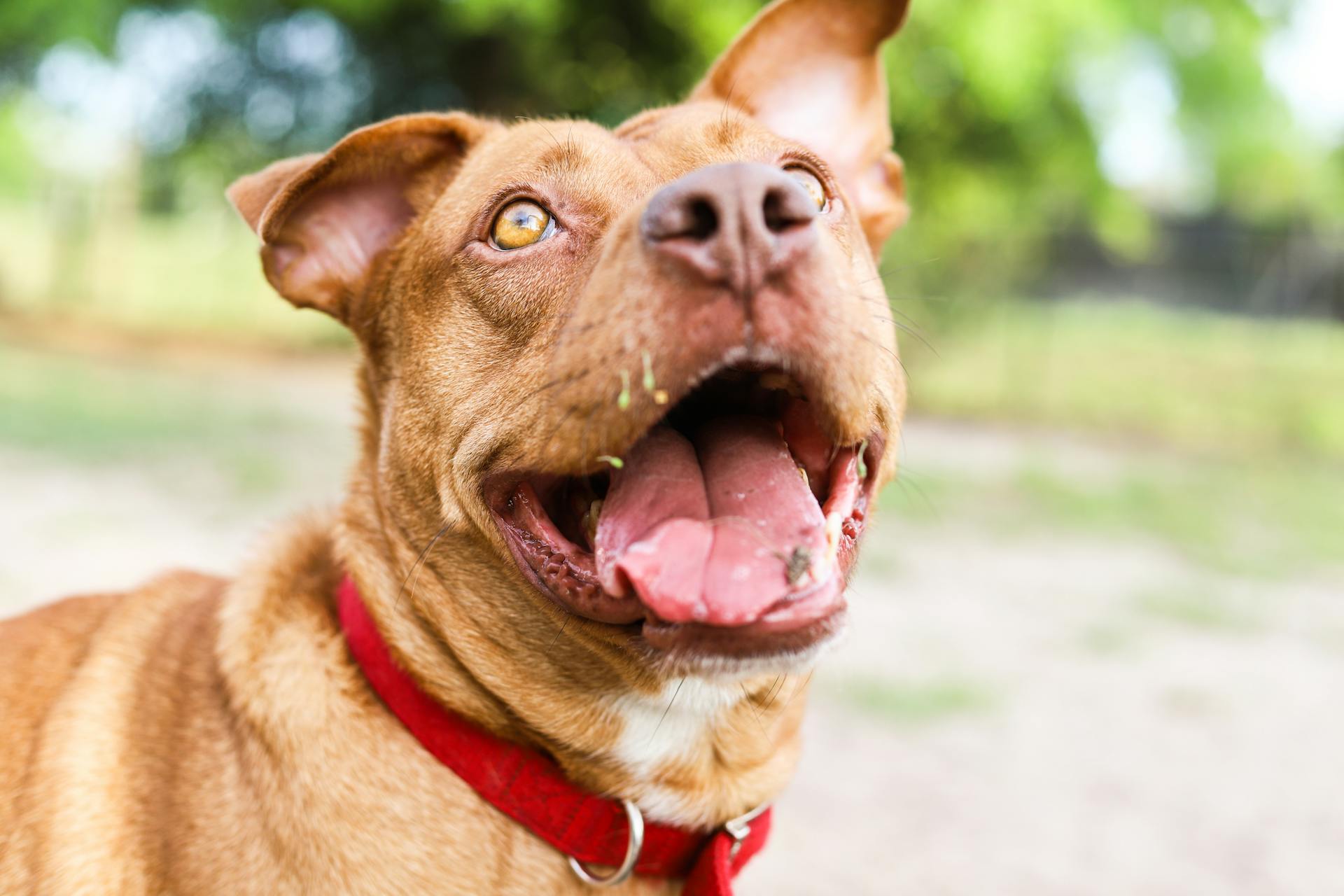
A dog's individual needs depend on their size, age, build, metabolism, and activity level. Highly active dogs need more food than couch potato dogs.
To prevent obesity, measure your dog's food and give meals at set times each day. This helps maintain a healthy weight and prevents overeating.
A healthy American Pit Bull Terrier should have a waist when looked down at and you should be able to feel their ribs beneath a layer of muscle but not see them. If the ribs are buried beneath fat rolls, it's time for a diet.
The quality of dog food makes a big difference – better food goes further in nourishing your dog, and you'll need less of it.
For your interest: Do Dogs like the Taste of Dog Food
Coat Color and Grooming
The American Pit Bull Terrier's coat is a beautiful thing, and with a little care, it can stay shiny and healthy-looking. Their short coat comes in a variety of colors, including red, blue, brown, grey, black, and white, and brindle.
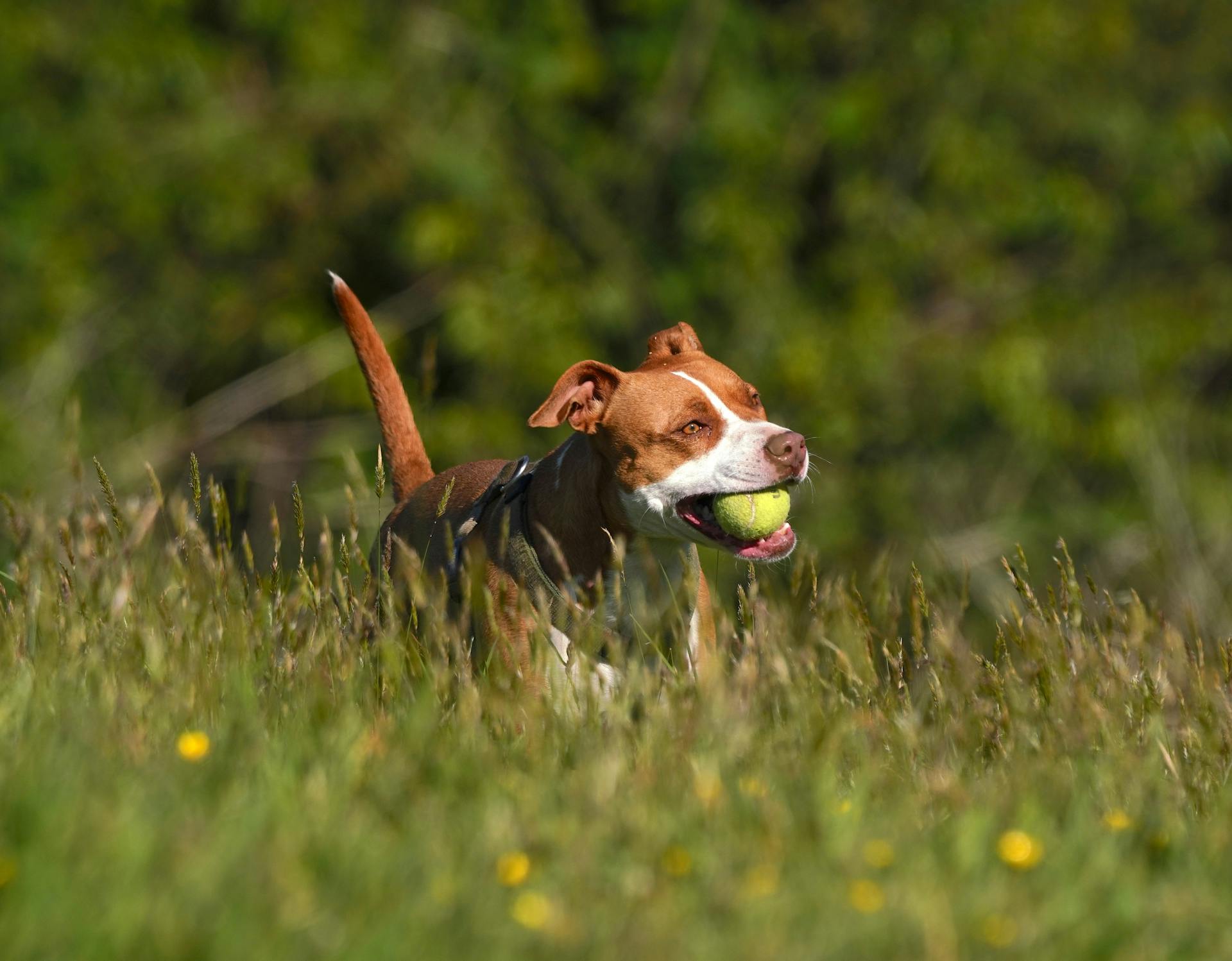
They require very little grooming, but the occasional bath will help keep their coat clean. Brushing with a stiff brush and wiping down with a cloth will maintain the coat's shine.
Brushing your dog's teeth is essential to prevent tartar buildup and gum disease. Daily brushing is even better than brushing just two or three times a week.
Trimming their nails once or twice a month is crucial to prevent painful tears and other problems. If your dog doesn't wear their nails down naturally, you'll need to take action.
You'll know their nails are too long if you hear them clicking on the floor. If you're not experienced in trimming dog nails, it's best to ask a vet or groomer for pointers.
Checking their ears weekly for redness or a bad odor is a must to prevent infections. You can wipe them out with a cotton ball dampened with gentle, pH-balanced ear cleaner.
Children and Pets
American Pit Bull Terriers love children and are ideal playmates, but no dog should ever be left unsupervised with kids.
They're sturdy and energetic, so they need to be crated or kenneled when no adult is around to supervise.
Children should never pull on a dog's ears or tail, and they should also be taught not to approach any dog while it's sleeping or eating, or to try to take the dog's food away.
Because of their dog-fighting heritage, some American Pit Bull Terriers retain a tendency to be aggressive with other dogs, but this can be minimized if they're socialized early and trained to know what behavior is expected of them.
They should always be supervised in the presence of other pets, just to be safe.
Frequently Asked Questions
What 4 breeds are pitbulls?
The four breeds often classified as pitbull types are the American Pit Bull Terrier, American Staffordshire Terrier, American Bulldog, and Staffordshire Bull Terrier. These breeds share physical and temperamental characteristics, but each has its unique features and history.
What is the big version of a pitbull?
The American Pit Bull Terrier is the tallest and most athletic of the pit bull types, known for their athletic build and UK heritage. If you're looking for a stockier breed, the American Bully might be the better fit, developed in the 1980s and '90s with a wider head than average pit bulls.
What 3 breeds make a pitbull?
The term "Pit Bull" refers to a group of 3 registered breeds: Staffordshire Bull Terrier, American Staffordshire Terrier, and American Pit Bull Terrier. These breeds are often misunderstood as a single breed, but are actually distinct types of dogs.
Is a dogo argentino a pitbull?
No, a Dogo Argentino is a distinct breed, not a type of pit bull. While they share some physical characteristics, they have different origins and temperaments.
Sources
- https://www.alphapaw.com/dog-breeds/pitbull-mix/
- https://resources.bestfriends.org/article/pit-bulls-everything-you-need-know
- https://www.ncbi.nlm.nih.gov/pmc/articles/PMC4160292/
- https://dogtime.com/dog-breeds/american-pit-bull-terrier
- https://inkopious.com/blogs/articles/difference-between-a-staffordshire-bull-terrier-and-pit-bull
Featured Images: pexels.com


